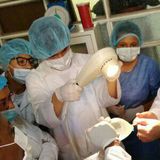

Some useful words👇👇👇👇👇👇👇👇👇 *Common Abbreviations* > Rx = Treatment. > Hx = History > Dx = Diagnosis > q = Every > qd = Every day > qod = Every other day > qh = Every Hour > S = without > SS = On e half > C = With > SOS = If needed > AC = Before Meals > PC = After meals > BID = Twice a Day > TID = Thrice a Day > QID = Four times a day > OD = Once a Day > BT = Bed Time > hs = Bed Time > BBF = Before Breakfast > BD = Before Dinner > Tw = Twice a week > SQ = sub cutaneous > IM = Intramuscular . . > ID = Intradermal > IV = Intravenous > Q4H = (every 4 hours) > QOD = (every other day) > HS = (at bedtime) > PRN = (as needed) > PO or "per os" (by mouth) > AC (before meals) > PC = (after meals) > Mg = (milligrams) > Mcg/ug = (micrograms) > G or Gm = (grams) > 1TSF ( Teaspoon) = 5 ml > 1 Tablespoonful =15ml ~ DDx=differential Diagnosis Tx=Treatment RTx=Radiotherapy CTx=Chemotherapy R/O=rule out s.p=status post PMH(x)=post medical history Px=Prognosis Ix=Indication CIx=contraindication Bx =biopsy Cx=complication... Knowledge About Blood. 1. Which is known as ‘River of Life’? Answer: Blood 2. Blood circulation was discovered by? Answer: William Harvey 3. The total blood volume in an adult? Answer: 5-6 Litres 4. The pH value of Human blood? Answer: 7.35-7.45 5. The normal blood cholesterol level? Answer: 150-250 mg/100 ml 6. The fluid part of blood? Answer: Plasma 7. Plasma protein fibrinogen has an active role in? Answer: Clotting of blood. 8. Plasma protein globulins functions as? Answer: Antibodies 9. Plasma proteins maintain the blood pH? Answer: Albumins 10. Biconcave discs shaped blood cell? Answer: RBC (Erythrocytes) 11. Non nucleated blood cell? Answer: RBC (Erythrocytes) 12. Respiratory pigments present in RBC? Answer: Haemoglobin 13. Red pigment present in RBC? Answer: Haemoglobin 14. RBC produced in the? Answer: Bone marrow 15. Iron containing pigment of Haemoglobin? Answer: Haem 16. Protein containing pigment of Haemoglobin? Answer: Globin 17. Graveyard of RBC? Answer: Spleen 18. Blood bank in the body? Answer: Spleen 19. Life span of RBC? Answer: 120 Days 20. Total count is measured by an instrument known as? Answer: Haemocytometer 21. A decrease in RBC count is known as? Answer: Anemia 22. An increase in RBC count is known as? Answer: Polycythemia 23. A high concentration of bilirubin in the blood causes? Answer: Jaundice 24. The disease resistant blood cell? Answer: WBC (leucocytes) 25. Which WBC is known as soldiers of the body? Answer: Neutrophils 26. Largest WBC? Answer: Monocyes 27. Smallest WBC? Answer: Lymphocytes 28. Antibodies producing WBC? Answer: Lymphocytes 29. Life span of WBC? Answer: 10-15 days 30. Blood cell performs an important role in blood clotting? Answer: Thrombocytes (Platelets) 31. Vessels is called? Answer: Thrombus 32. Anticoagulant present in Blood? Answer: Heparin 33. A hereditary bleeding disease? Answer: Haemophilia 34. Bleeder’s disease? Answer: Haemophilia 35. Christmas disease? Answer: Haemophilia 36. A type of Anemia with sickle shaped RBC? Answer: Sickle cell anemia 37. Viscosity of Blood? Answer: 4.5 to 5.5 38. Instrument used to measure haemoglobin? Answer: Haemoglobinometer 39. Who demonstrated blood groups? Answer: Karl Landsteiner 40. Who demonstrated Rh factor? Answer: Karl Landsteiner 41. Blood group which is called Universal donor? Answer: O 42. Blood group which is called Universal recipient? Answer: AB 43. Blood group is most common among the Asians? Answer: B MEDICAL TERMINOLOGY Everybody should know the basic functioning of Human Body and its main parts in order to express and explain their ailment to the Doctor and at the same time one should be able to understand the diagnosis expressed by the Doctor in the medical terminology. For easy recognition of the Compounded Words used in the Medical Terminology for naming the disease, Suffixes are added to Prefixes. For this hereunder giving you a few such prefixes for your ready reference and understanding. Prefix - Meaning 1. Adeno - Glandular 2. An - Not 3. Anti - Against 4. Aorto - Aorta 5. Artho - joint 6. Bleph - Eyelid 7. Broncho - Bronchi 8. Cardio - Heart 9. Cephal - Head 10. Cerebro - Brain 11. Cervico - Cervix 12. Cholecysto - Gall Bladder 13. Coli - Bowel 14. Colpo - Vagina 15. Entero - Intestine 16. Gastro - Stomach 17. Glosso - Tongue 18. Haema - Blood 19. Hepa - Liver 20. Hystero - Uterus 21. Laryngo - Larynx 22. Leuco - White 23. Metro - Uterus 24. Myelo - Spinal cord 25. Myo - Muscle 26. Nephro - Kidney 27. Neuro - Nerve 28. Odonto - Tooth 29. Orchido - Testis 30. Osteo - Bone 31. Oto - Ear 32. Pharyngo - Pharynx 33. Pio - Pus 34. Pneumo - Lung 35. Ren - Kidney 36. Rhin - Nose 37. Spleno - Spleen 38. Thyro - Thyroid Gland 39. Urethro - Urethra 40. Vesico – Bladder Here are the suffixes used in Medical terminology. Check out! Suffix - Meaning 1. -aemia : Blood 2. -algia : Pain 3. -derm : skin 4. -dynia : pain 5. -ectomy : removal 6. -Itis : inflammation 7. -lithiasis : Presence of Stone 8. -malacia : softening 9. -oma : tumour 10. -opia : eye 11. -osis : Condition,excess 12. -otomy : incision of 13. -phobia : fear 14. -plasty : surgery 15. -plegia : peralysis 16. -ptosis : falling 17. -rhoea : excessive discharge 18. -rhage : to burst forth 19. -rhythmia : rhythm. 20. -stasis : stoppage of movement 21. -sthenia : weakness 22. -stomy : outlet 23. -tomy : removal 24. -trophy : nourishment 25. -uria : urine
I have a question ... are these terms worldwide standardized ? 🤔
Rx is a latin symbol which stands for 'Recipe' which means 'to take'...which is then followed by the apt medications in a prescription









